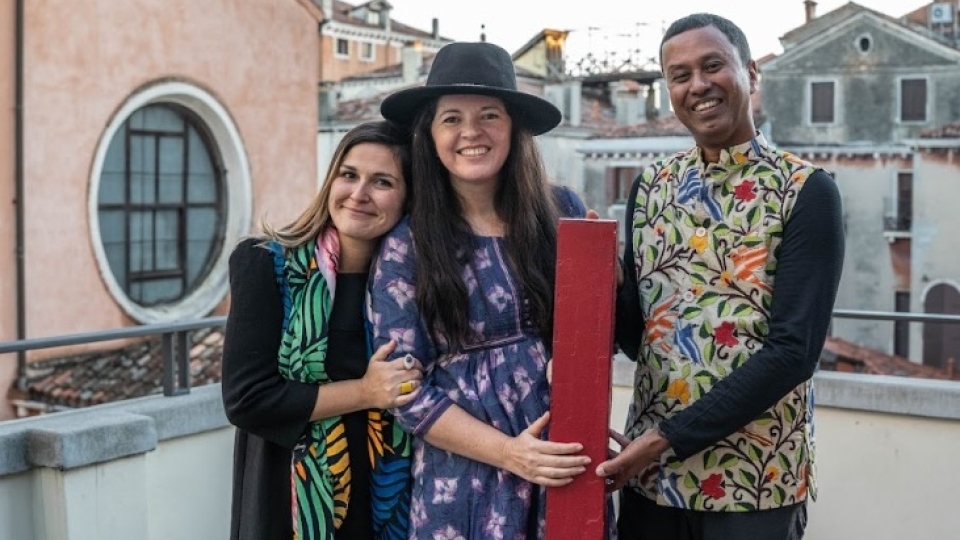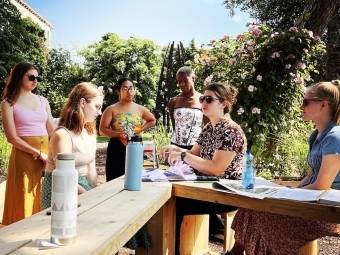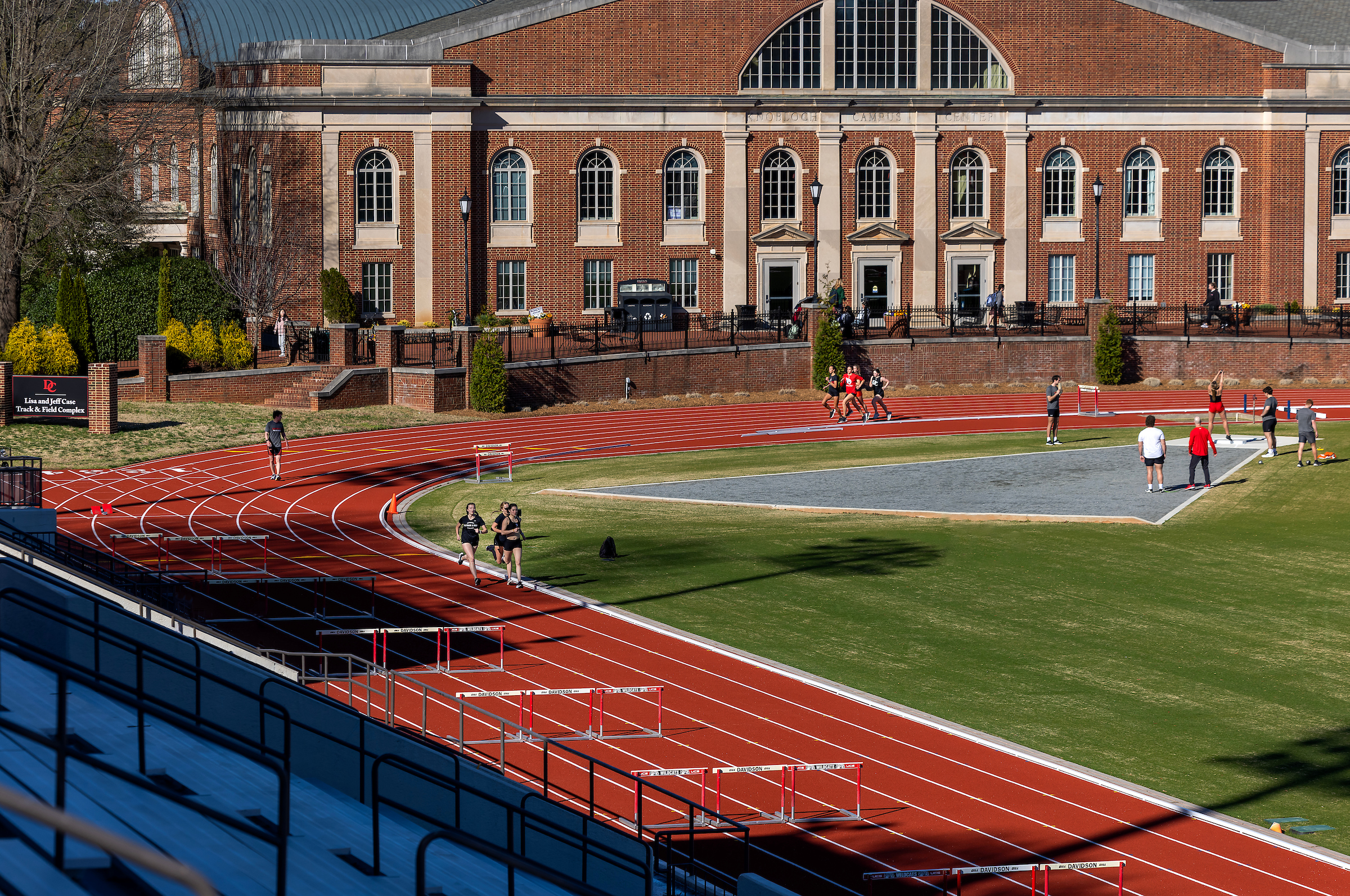From Outdoor Classroom to World Stage: Prof Takes Home Venice Biennale Award
December 8, 2022
- Author
- Mary Elizabeth DeAngelis

Co-curators Jennifer Garcia Peacock (center) and Subhankar Banerjee with Lucia Pedrana, head of university relations, European Cultural Centre, Venice, celebrate their award for A Library, a Classroom, and the World, after a Nov. 27 ceremony. (Photo credit: Riccardo Sottoriva)
Many artists dream of heading to Italy for Venice Biennale, known as “The Olympics of the Art World.”
Davidson College Assistant Professor Jennifer Garcia Peacock gladly accepted an invitation to co-curate a project in Venice during this year’s event.
In an especially happy ending, Garcia Peacock will come home with a gold: The European Cultural Centre’s (ECC) top award for Universities and Research-based Projects.
“It’s been such an honor to represent Davidson on the global stage,” Garcia Peacock said. “And it was so special to include students in the work that led us here.”
Venice is a city awash in art. Venice Biennale, which ran from April through November, supersizes that. Art exhibits fill virtually every nook of the city and attract locals and visitors from around the world. Different countries showcase their art through the festival’s official national pavilions.
Outside of the festival, a variety of international and non-profit cultural agencies, including the ECC, also host highly acclaimed exhibits. Garcia Peacock’s was one of about 200 projects in the ECC’s Personal Structures exhibit. The ECC estimated that some 520,000 people visited Personal Structures.
The award Garcia Peacock received says her project, A Library, a Classroom, and the World, “represents a successful attempt of involving the city of Venice, with its culture, traditions and territory. A genuine proof of interaction and a smart application of art in the field of ecology.”

Prof. Jennifer Garcia Peacock, Prof. Annie Merrill, and six students of the Environmental Justice Art class from Davidson College; in the outdoor classroom of a Library, a Classroom, and the World, Marinaressa Gardens, Venice Biennial Art exhibition Personal Structures: Reflections, Venice, Italy (photo by Subhankar Banerjee, May 2022).
Pandemic Creation
Some of Garcia Peacock’s inspiration came from the COVID-19 pandemic, when many classes met online. She worked with the college to build an outdoor classroom for students to gather safely in person.
A Library, a Classroom, and the World had both indoor and outdoor locations. She co-curated its many components with Subhankar Banerjee, a University of New Mexico professor.
Their team crafted a library in the historic Palazzo Bembo along the Grand Canal near the Rialto bridge. Displays included drawings, digital illustrations, photographs, poetry and extensive narrative and scholarly text. Artists spent time talking with visitors about their work.
The team installed the outdoor classroom in the Marinaressa Gardens along the Venice Lagoon. With welcoming benches, lush plants, and a waterfront view, it became a popular destination for residents and visitors.
Last spring, students in Garcia Peacock’s environmental justice art class conducted research and capstone projects about some of the featured artists. In May, they went to the Venice Biennale.
“It was such an amazing experience,” said Marquia Humphries ’22, an art major who flew to Venice the day after she graduated. “This was my first time traveling internationally, and the exhibit was so good.”
She loved starting her days with the others in the outdoor classroom.
“Residents of Venice were really utilizing that space,” Humphries said. “People of all ages came. Kids played, older people admired the roses, couples strolled through. So many people have benefitted from the classroom’s creation—including myself.”
The Art of Imagination
The Venice Biennale festival was originally founded in 1895 to showcase “the most noble activities of the modern spirit without distinction of country.” This year’s official theme was “The Milk of Dreams,” a title of a children’s book by the late artist Leonora Carrington. It describes a world that can be transformed by imagination.
Imagination played prominently in both the official and surrounding exhibits.
Garcia Peacock, the James B. Duke Assistant Professor of Environmental Studies, specializes in 20th century American and Latinx history, environmental history and visual culture. She and Banerjee worked together before, and he served as Davidson’s 2020 Bacca Artist-in-Residence.
They wanted A Library, a Classroom, and the World to “build bridges across places, peoples, and time,” a theme connected by their proximity to Venice’s famous bridges. The exhibit, their description explains, “rebels against our frenzied time and … urges a visitor to slow down to take a look.”
Featured artists came from diverse and often underrepresented backgrounds. Garcia Peacock says their work prompted visitors to talk about loss: From the pandemic, violence, racism and climate change—and how to steer the world away from its most destructive tendencies.
“It was great to have these spaces filled with people who were so engaged in these conversations,” she said. “It was really humbling and inspires you to hope, and to keep pushing toward these imagined futures.”
The UNM Center for Environmental Arts and Humanities, which Banerjee founded and directs, and the Environmental Studies Department at Davidson College provided funding, support and co-produced the project for Personal Structures.
The Davidson students spent a week exploring Personal Structures and other Venice Biennale exhibits. They put reports together and shared what they learned with other visitors. Annie Merrill, the Thomson Professor of Environmental Studies, also traveled with them.
Some 80 countries participated through Venice Biennale’s national pavilions this year. A few, including Uganda, were first timers.
Wandering through Uganda’s pavilion brought Louisa Bartkovich ’22 back to her childhood. She spent the first eight years of her life in Uganda, and still misses it.
Like Humphries, her close friend and former Davidson roommate, she went to Venice the day after graduating. Looking at familiar scenes from her childhood on display, she felt a full-circle moment.
“Seeing the Ugandan artists’ portraits—especially of women—was very moving,” Bartkovich said. “You could see their struggles and their hopes so clearly in their faces.”
“I love art, and the conversations that can start around it. And in my case, the entire trip was an incredibly human and emotional experience,” she said. “I have never been able to return to Uganda, but standing in the Ugandan pavilion, the art somehow transported me home.”

(left to right) Gabriela Nahm '24, Caroline Wack '23, Lilliana Sandoval '23, Marquia Humphries '22, Louisa Bartkovich '22, Claudia Craig '24


